May 2, 2023
Kutani ware artists continue tradition of bold designs, bright colors, commitment to quality
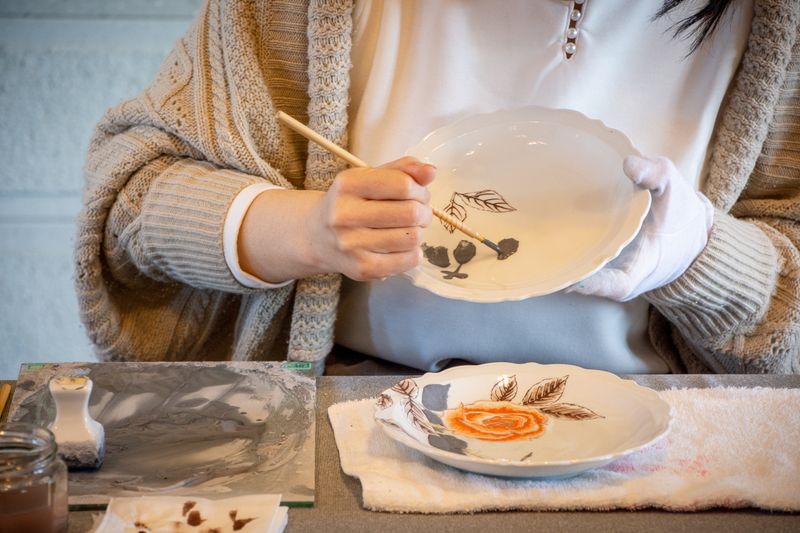
Many of the designs and flourishes which adorn pieces of Kutani ware porcelain on display at the Kutaniyaki Art Museum in Ishikawa Prefecture have the extravagance of an oil painting.
Despite originating from only five core colors, it's the bold designs and bright colors of Kutani ware that are its calling card, and have been since production began more than three centuries ago.
The Kutaniyaki Art Museum is located in the Daishoji district of Kaga City, around 20 km north of where the first Kutani-yaki pottery kiln was fired-up during the early Edo Period (1603 - 1867) - in Kutani Village in the mountainous border area between present-day Ishikawa and Fukui prefectures.
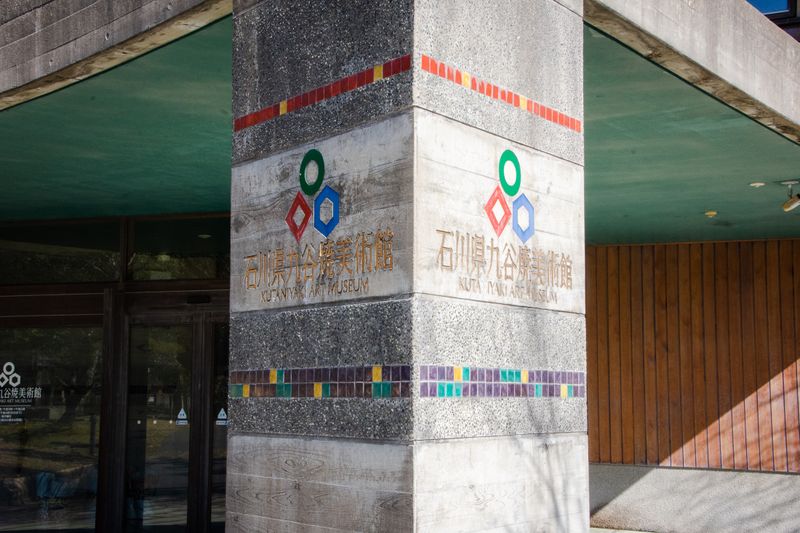
(Kutaniyaki Art Museum, Kaga City, Ishikawa Prefecture. Photo taken March 2023.)
Kutani ware in its earliest form is referred to as Ko-Kutani, or “old Kutani,” and was used by the lords of the then Daishoji Domain - which fell under the wider Kaga Domain (roughly present-day Ishikawa and Toyama prefectures) ruled by the Maeda Clan - to entertain or present to guests.
During the 1650s, the early years of Japan’s Sengoku “Warring States” Period, Kutani ware plates were produced and used to serve food for samurai. The food was consumed revealing beautiful patterns on the plates.
“Right now you can see a lot of colorful plates but back then, during the feudal era, these kinds of plates were precious, like jewelry,” said Seinosuke Shouzu curator at the Kutaniyaki Art Museum.
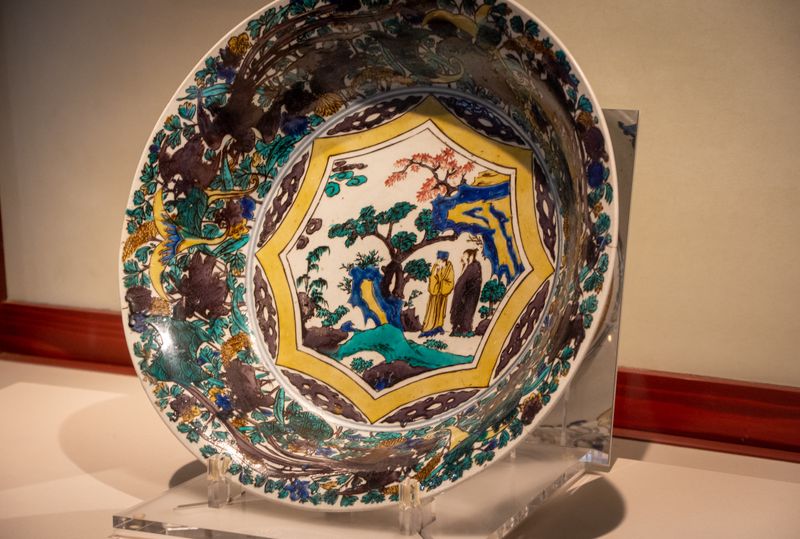
(Kutani ware plate showing the vivid five colors of green, yellow, blue, purple and red called Kutani gosai, Kutaniyaki Art Museum. Photo taken March 2023.)
Shouzu pointed out a dish used to serve confectionery as part of the tea ceremony - where participants are invited first to enjoy sweet delicacies before taking tea.
“Before enjoying the tea, guests were entertained with beautiful dishes like this, and they would have been impressed,” Shouzu said.
“Guests would need to have been cultured people in order to have been able to appreciate the dishes. Some have poems written on them which would have required some understanding from the guest. They should have been cultured or sophisticated people.”
Such was the intricacy of some Kutani ware designs that menso brushes made from the whiskers of a mouse were sometimes used in their production.
The designs and colors of Kutani ware, along with the higher cultural sensibilities required for their full enjoyment may have been ahead of their time.
While extravagant porcelain tableware might have a strong association with the pomp and finery of castles, palaces and country estates in Europe, when Kutani ware first started emerging from the flames of kilns in Daishoji there was no porcelaine like it to be found on the continent, according to Shouzu.
It wasn’t until around 100 years after the emergence of Kutani ware that the Europeans began producing a similar kind of porcelain, in Germany.
The finery and sophistication of Kutani ware perhaps belies its origins and raw, earthly production which started with the discovery of porcelain stone during the development of a mine in the village after which the porcelain was to be named.
The solid white stone is ground and turned into clay before being formed into a dish or vessel. This is then fired in a kiln at around 1,300 degrees Celsius for three days.
Colors used for the designs are created by mixing manganese with other chemical elements and compounds, including cobalt and iron oxide.
Ko-Kutani production only lasted for around 50 years before ceasing, the reasons for which remain unknown. Some people speculate that the struggling rulers of the Daishoji Domain didn’t have the funds to continue financing production.
A Kutani ware revival began in the late Edo Period, in the city of Kanazawa, with the help of potters from Kyoto but the Meiji Restoration which saw the end of the ruling Shogunate left Kutani artists without support from the feudal lord. This, however, forced them to become self-sustaining.
The potters of Daishoji focused their efforts to strengthen their reputation by further improving the quality of their work as individual artists rather than as one of a number of craftsmen based at the same kiln, according to the Kutaniyaki Art Museum.
Quality over quantity seems to be a common theme running through the history of Kutani ware, up to the present day.
Kutani artist Shiho Aikawa is one of 18 female artists who are part of the initiative Wear Kutani, based in the city of Nomi, Ishikawa Prefecture.
Where Kutani ware was traditionally used in large plates and ceremonial vessels, one of the aims of the Wear Kutani initiative is to make Kutani items more accessible as something which can be worn.
The commitment to quality, however, remains. With each item from the initiative made by hand there is no room for mass production and there are as yet no plans for online sales. Instead, Wear Kutani pieces are toured and showcased at exhibitions and events where they may be available for purchase.
“I love the Kutani designs. I think they’re amazing. The modern and the old. I feel like even the old designs can fit with modern lifestyles. That’s one of the great things about Kutani ware,” Aikawa said during a demonstration of her work at the museum in March.
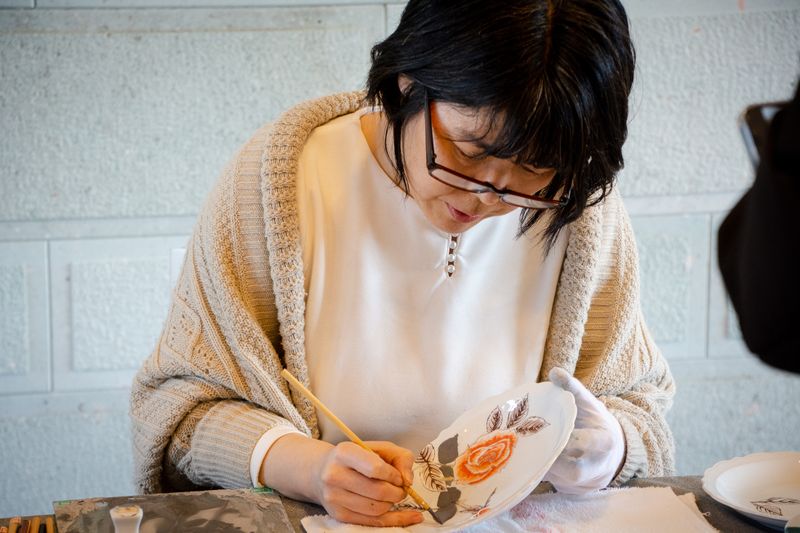
(Kutani artist Shiho Aikawa at the Kutaniyaki Art Museum, Ishikawa Prefecture. Photo taken March 2023.)
Today’s Kutani artist branches out from the traditional five colors with which the early artists worked.
“After a lot of testing we can decide which colors should be combined and each artist explores their own use of these colors,” she said.
Incredibly, the colors don’t emerge until after the item has been fired in the kiln leaving the artists to call upon their imagination as to what the effect might be. It’s a process which appears some way removed from the routines of office life in which Aikawa made a living before becoming a Kutani artist.
“Working in an office I was always looking at the screen of a computer. Instead of just clicking on something as my work I wanted to shape something, to make something with my own hands,” she said.
Aikawa went on to graduate from a Kutani-yaki training institute in Ishikawa Prefecture in 1999 and was certified as a traditional craftsperson of Kutani-yaki decoration in 2018.
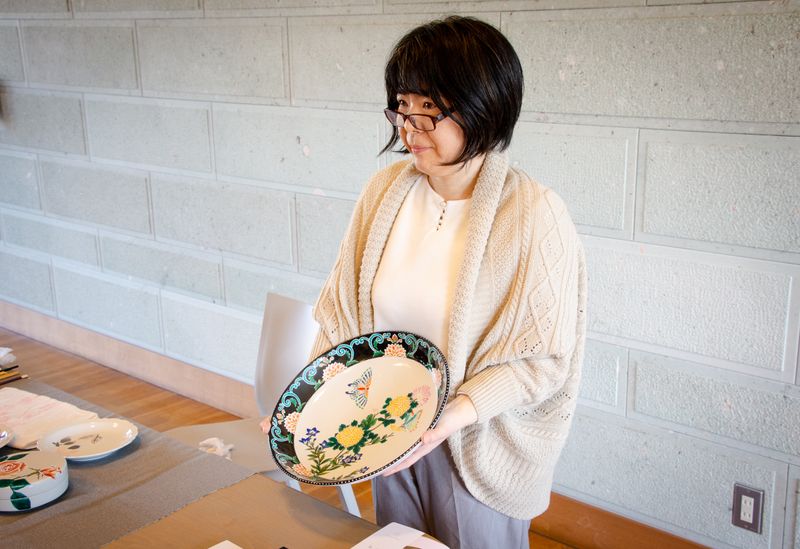
(Kutani artist Shiho Aikawa at the Kutaniyaki Art Museum, Ishikawa Prefecture. Photo taken March 2023.)
“Actually, porcelain works are produced all over Japan. Some of the main differences between each of them are determined by the local materials or the clay that are available. Here the clay gives Kutani ware this slight gray color and a shiny glass finish, which is a unique combination,” she said.
“That kind of characteristic has been handed down from generation to generation here. Maybe it might be in our DNA.”
She was joking, of course, but the commitment to quality over quantity in the Kutani artist, it seems, continues to be something taken very seriously to this day.
Related
JAPAN’s next TOP TRAVEL DESTINATION? Traveling through Fukui & the Hokuriku Sanken
Fukui’s old traditions, temples await new arrivals with shinkansen extension
Ainokura’s gassho-zukuri residents share stories of the way things used to be



0 Comments